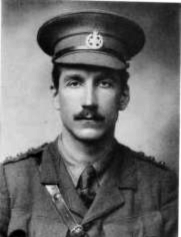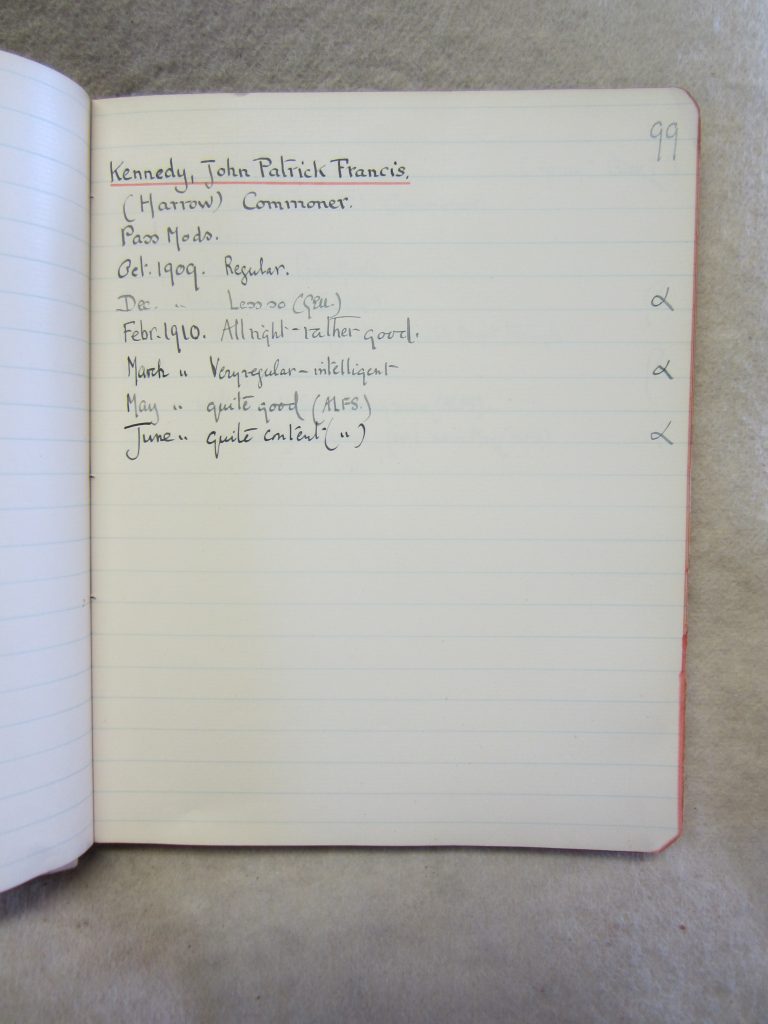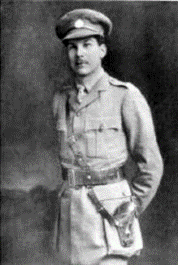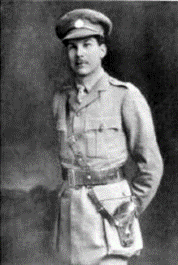Fact file:
Matriculated: 1909
Born: 18 September 1891
Died: 24 April 1918
Regiment: Rifle Brigade
Grave/Memorial: Crucifix Corner Cemetery, Villers-Bretonneux; III.D.3.
Family background
b. 18 September 1891 in Santiago, Chile, as the fourth and youngest son of Sir John Gordon Kennedy, KCMG (b. 1836 in Naples, d. 1912) and Lady Evelyn Adela Kennedy (née Bootle-Wilbraham) (1850–1939) (m. 1877), of 50, Cranley Gardens, South Kensington, London SW7, then Burnthouse, Cuckfield, Sussex. At the time of the 1911 Census the family was living at “Holmhurst”, St Leonards-on-Sea, Sussex (eight servants).
Parents and antecedents
Kennedy’s father was the son of John Kennedy (1805–1845), British Chargé d’Affaires in Naples and a great-grandson of Captain Archibald Kennedy, RN, the 11th Earl of Cassillis (d. 1794). After being educated at Harrow and Corpus Christi College, Oxford, he entered the Foreign Service in 1857 and served successively in Paris, Vienna, Washington and Constantinople. He was promoted Second Secretary in October 1865 and subsequently transferred to Brussels, Rome and Tokyo, where he was promoted to Secretary of the Legation in 1878. After a spell in St Petersburg (1881) and a second spell in Rome (March 1885) he became Minister Resident and Consul-General at Santiago, Chile (September 1888), and Envoy Extraordinary and Minister Plenipotentiary to the King of Romania (September 1897). He was made a KCMG in 1901 and retired in 1905. One of John Gordon’s brothers, Admiral Sir William Robert Kennedy (1838–1916), was at one time Commander-in-Chief, The Nore. Another brother, Gilbert George Kennedy (1844–1909), was a noted sportsman, an athletics blue at Cambridge and a regular player the Wanderers football team, and he played for Scotland in the second international match against England in 1870. He became a barrister and eventually a Metropolitan Police Magistrate, serving in the Marlborough Street Police Court and later in Greenwich and Woolwich. One of his sons, Kennedy’s cousin Humphrey Hayes Kennedy, a Lieutenant-Colonel in the Seaforth Highlanders, was killed in France by a stray German shell on 29 July 1918.
Kennedy’s mother was the daughter of Edward Bootle-Wilbraham (1807–82) the second son of the 1st Baron Skelmersdale (1771–1853). His nephew, also Edward, was a Conservative politician serving in every Conservative administration between 1866 and 1898. He succeeded his grandfather as the 2nd Baron Skelmersdale and was created the 1st Earl of Lathom in 1880. Kennedy’s maternal grandfather was a professional soldier who rose to the rank of Colonel in the Coldstream Guards. During World War One, Kennedy’s mother spent much time and effort on relief work, especially the organization of parcels for prisoners of war. During the 1870s, she and her two sisters were well-known and popular in the society of London and Rome. The oldest sister, Ada Constance (1846–1934), married Onorato Gaetani (1842–1917), the 14th Duke of Sermoneta and a member of the most ancient of the Roman princely families, which produced two Popes (1118 and 1294) and eleven Cardinals (1082–1626). They had five sons, one of whom, Livio (1873–1915), died at Padua during his military training. In 1869 the second sister, Emily Florence Bootle-Wilbraham (1848–1934) married James Ludovic Lindsay (1847–1913), the 26th Earl of Crawford and Balcarres, from one of Britain’s most ancient noble families. Their oldest son, the Hon. Alexander David Lindsay, later the 27th Earl of Crawford and 10th Earl of Balcarres (1870–1940), studied History at Magdalen from 1891 to 1894 and became a Conservative politician; during World War One he served for a year as a medical orderly in the Royal Army Medical Corps before returning to politics in 1916. Their sixth son, the Hon. Lionel Lindsay, MC, married Kennedy’s older sister.
Kennedy’s paternal grandfather John Kennedy was also the paternal grandfather of Captain Edward Coverley Kennedy, RN (1879–1939), the Commanding Officer of the HMS Rawalpindi, a merchant cruiser (converted passenger liner) that had been requisitioned by the Admiralty on 26 August 1939 and armed with eight six-inch and two three-inch guns. On 23 November 1939, while on patrol north of the Faroe Islands, it fought a hopeless action against the Scharnhorst and the Gneisenau, two of Germany’s most modern warships, instead of surrendering. The Rawalpindi was sunk within 40 minutes, with the loss of 238 of its men, including its 60-year-old Captain. Captain Kennedy was the father of the journalist, author and broadcaster Ludovic Kennedy (1919–2013).
Siblings and their families
Brother of:
(1) Archibald Edward (1878–1914); killed in action on 26 August 1914 at Le Cateau while serving as a Captain with the 2nd (Regular) Battalion, the Argyll & Sutherland Highlanders;
(2) Kathleen Yone (1880–1970); later Lindsay after her marriage in 1921 to her cousin the Hon. Lionel Lindsay, MC (1879–1965); one son;
(3) Olive (b. 1882 probably in Chile, d. 1932);
(4) Paul Adrian (1886–1915); killed in action on 9 May 1915 on Aubers Ridge while serving as a Captain with the 2nd (Regular) Battalion, the Rifle Brigade;
(5) (Aubrey) Leo (1885–1965) (later MC, Croce di Guerra); married (1921) Sylvia Dorothy Meysey-Thompson (1895–1968); three daughters.
Archibald Edward landed at Boulogne on 14 August 1914 with the 2nd(Regular) Battalion of the Argyll & Sutherland Highlanders and was killed in action 12 days later, aged 35, when it was fighting a rearguard action at Le Cateau during the retreat from Mons.
Kathleen Yone became a Red Cross nurse during World War One and in this capacity served near the front in the later stages of the war.
After attending Harrow School and the Royal Military College (Sandhurst), Paul Adrian was gazetted Second Lieutenant in the 4th (Regular) Battalion of the Rifle Brigade (The Prince Consort’s Own) in 1906, and served with it in Malta, Egypt and India. But when he found himself on leave in England in August 1914, he asked to be attached to a home battalion and was duly posted to the Regiment’s 3rd (Regular) Battalion, with which he disembarked at St-Nazaire as part of the 17th Brigade, in the 6th Division, on 12 September 1914. Soon after the Battalion’s arrival, he was wounded during the Battle of the Aisne and invalided home. In December 1914, he was attached to the Regiment’s 8th (Service) Battalion and subsequently offered two Staff appointments, which he refused, preferring to return to the front. He disembarked in France for the second time on 17 March 1915 and joined his Regiment’s 2nd (Regular) Battalion in the 25th Brigade, part of the 8th Division, as a Captain and Company Commander. He was killed in action by a sniper at Aubers Ridge on 9 May 1915, aged 28, while leading his Company in the vanguard of the attack by the 25th Brigade on the German trench system along the Sailly–Fromelles Road. His Company became isolated, so Paul fell in the German lines, and although two Riflemen were left with him, he would not let them stay and sent them back to their own lines. Only three officers and 250 other ranks of the Battalion returned unwounded that day. He has no known grave, and is commemorated on a private monument just outside the village of Fromelles.

Paul Adrian Kennedy
(Aubrey) Leo also attended Harrow School and then, like his brother John Patrick Francis, studied at Magdalen College, Oxford (1903–06), where he read for a Pass Degree. In 1910, he joined the staff of The Times as a sub-editor, where he developed his already pronounced interest in international relations, especially European politics. He was rapidly promoted by being sent to Paris, and then, from 1912 onwards, he reported on the Balkan Wars from Belgrade, then Bucharest, and finally from within Albania. During World War One he served in the King’s Own Yorkshire Light Infantry, the Intelligence Corps, the Scots Guards and the Royal Flying Corps, and in late 1916 he was awarded the MC. The war deepened his interest in European politics and the international situation, and in 1920 he became a founder member of the Royal Institute of International Affairs (now Chatham House). In autumn 1919, the Editor of The Times sent him to report on the Europe that was emerging after the signing of the Treaty of Versailles. His return from that journey coincided with the last days of the régime at The Times of its dirigiste owner, Lord Northcliffe (1865–1922), and as Leo was not happy with the resultant situation he resigned and used the next four years to continue his study of international relations. His first book, Old Diplomacy and New: From Salisbury to Lloyd George, appeared in 1922. In 1923, after Northcliffe had died and control of The Times had passed to the Astor family, Geoffrey Dawson (1874–1944; Magdalen 1893–97; surname Robinson until 1917), who had been the newspaper’s Editor from 1912 to 1919, was reappointed to the Editorship. He immediately reappointed Leo to write leading articles on international, and especially European, affairs and used him as The Times’s Special Correspondent in Europe. As a result, Leo was able to travel extensively on the Continent, attend meetings of the League of Nations in Geneva, and become acquainted with most of the prominent political figures in inter-war Europe. Then, in 1936, when the Berlin correspondent of The Times had to resign for health reasons, Leo took over his post for three months and so had to report on Hitler’s remilitarization of the Rhineland.
Leo’s experience of the ease with which Hitler, then and on future occasions, broke his verbal assurances that Germany would make no more territorial demands in Europe, plus his growing conviction that the growing threat that was posed by Hitler could be met only by the revision of the Treaty of Versailles, led him to write more strongly worded pieces for The Times than were acceptable to his friend Dawson and to Dawson’s assistant editor, Robin Barrington-Ward, DSO, MC (1891–1948), both of whom believed in appeasement. In early 1937 Leo published Britain Faces Germany, an ambivalent book in which he counselled his readers to pay less attention to Hitler’s undertakings and more to the views that he had put forth in the unabridged version of Mein Kampf, while arguing that a “just and honourable settlement”, negotiated between Britain and Germany over such issues as the terms of the Treaty of Versailles and colonies, was the only way of healing the growing rift between the two countries and avoiding war. And during the autumn of 1938, i.e. in the run-up to the Munich Agreement of 30 September, Leo’s increasing fear of Hitler caused him to repeat his views in a series of letters and articles that appeared in The Times. This generated a long riposte on 28 October 1938 from Dr Fitz Randolph of the German Embassy in which he repeated Hitler’s territorial promises and assured the Times’s readership of Germany’s goodwill and peaceful intentions. In 1942 Leo left The Times and spent the rest of the war working as the Diplomatic Correspondent of the BBC’s European Service. After the war he published a well-received single-volume account of Lord Salisbury as Prime Minister (1953) and frequently contributed articles to The Quarterly Review. His extensive papers were deposited in Churchill College, Cambridge, in 1985.
Sylvia Dorothy Meysey-Thompson was the daughter of Arthur Herbert Meysey-Thompson (1852–1950), one of the founders of the Yorkshire Electric Power Company.
Education
Kennedy may have attended Denstone Preparatory School (a Woodard School that was founded in 1902 and moved in 1938 to Smallwood Manor, Uttoxeter, Staffordshire) from 1902 to 1905. Following his three brothers, Kennedy then attended Harrow School from 1905 to 1909, and matriculated at Magdalen as a Commoner on 13 October 1909, having passed Responsions in Hilary Term 1909. He passed the First Public Examination in Hilary Term 1910 and then read for an Honours Degree in Modern History. In Trinity Term 1912 he was awarded a 3rd in Modern History (Honours), and he took his BA on 16 January 1913. After studying languages abroad (1913–14), he came third in the Foreign Office Examination in August 1914.

John Patrick Francis Kennedy, BA
Magdalen College Group photograph 1912
(Photo courtesy of Magdalen College, Oxford).

Kennedy’s academic record (1909-12), compiled by H. W. Greene et al., Magdalen College Archives: F29/1/MS5/5 (Notebook containing comments by H. W. Greene et al. on student progress [1895-1911]), p. 99.
Kennedy joined the 14th (Service) Battalion of the Rifle Brigade (The Prince Consort’s Own) as a Temporary Lieutenant on 8 October 1914 and for some months acted as its Adjutant, probably because he had a university degree. On 31 December 1914 he was commissioned Second Lieutenant on probation in the 5th (Reserve) Battalion of the same Regiment, and on 5 October 1915 he was part of a draft of five subalterns who joined the 2nd (Regular) Battalion in France, when it was part of 25th Brigade in the 8th Division, i.e. the same battalion as the one in which his elder brother Paul Adrian had been serving when killed in action on 9 May 1915 during the Battle of Aubers Ridge. Unfortunately, the Battalion War Diary tells us nothing about the 2nd Battalion’s precise location until 1 January 1916, when it was said to be resting in billets near a place called Boberhem – which I have not been able to locate. But we do know that on 18 October 1915 the 25th Brigade moved from the 8th to the 23rd Division and was used to instruct inexperienced troops in trench warfare. This means that it was probably still in the area near Fromelles, since by then that part of the Western Front had become very quiet and so a suitable area for such instruction. This is also suggested by the fact that on 9 January 1916 the 2nd Battalion moved to billets near Estaires, north of Béthune, and on 10 January to billets near Fleurbaix, some six miles further east, where it rested until 14 January. It subsequently spent two periods in trenches somewhere between Fleurbaix and Fromelles (14–18 January and 30 January–1 February), interspersed with rest periods in nearby billets in unnamed locations. However, on 8 February, two days into a third spell in the trenches, Kennedy was severely wounded “while on patrol attempting to capture some of the enemy”, who, the War Diary continues, were expecting a raid “owing to activity of our patrols & became very vigilant”.

John Patrick Francis Kennedy, BA
(Photo courtesy of Magdalen College, Oxford).
In 1917, when Kennedy was fit enough for home duties, he was appointed aide-de-camp to General Sir Bruce Hamilton, GCB, KCVO (1857–1936), the General Officer Commanding Northern Army and Army Home Defence throughout World War One. On 27 March 1918, after being passed fit again for active service, he was reassigned to the 2nd Battalion of the Rifle Brigade, six days after the beginning of Operation Michael and four days after the 2nd Battalion had lost 12 officers and around 300 other ranks (ORs) killed, wounded or missing during the rearguard action at the bridgehead at Pargny, on the Somme, 13 miles south of Péronne. Two days later the Battalion would lose a further four officers and around 50 ORs at Morchain, about two miles to the west of Pargny. But Kennedy did not report for duty in France until 4 April 1918, when the Battalion, which had continued its withdrawal westwards until 1 April 1918, was still in line at Thennes, about six miles south-east of Amiens, i.e. at the limit of the German advance. Because of the Battalion’s considerable losses, Kennedy was immediately promoted Captain and given command of ‘C’ Company. Then, between 4 and 20 April, the Battalion rested, absorbed new recruits, and trained – first at Cottenchy, three miles west of Thennes, and then near the village of Le Mesge, 19 miles away and well to the west of Amiens.
On 20 April the ill-prepared Battalion returned to the front line near Villers-Bretonneux, a fairly large town about eight miles east of Amiens that straddles the Roman road (D1029) running east–west from St-Quentin to Amiens, and spent two quiet days there despite the report that the Germans would attack at dawn on 23 April. They did not, but at 03.45 hours on 24 April the attack finally began with a heavy artillery barrage that lasted until 07.00 hours and included many gas shells. The morning was misty, with visibility down to 20 yards, and at dawn the Germans supplemented their artillery barrage with a thick smoke screen that enabled them to outflank ‘D’ Company and move in towards Kennedy’s ‘C’ Company, causing casualties. Finally, the Germans managed to break through the British line south of Villers-Bretonneux, turn northwards and penetrate the British lines by getting in between the front and the reserve lines of the 2nd Battalion, “being unobserved owing to the dense mist and smoke barrage”. As a result, ‘A’ and ‘C’ Companies were taken unawares in the rear and overwhelmed “after a sharp fight by superior numbers of the enemy”. The battle was the first occasion when German tanks were employed and about five participated in the capture of Villers-Bretonneux; this was also the first occasion in the history of land warfare when tanks clashed with hostile tanks. Kennedy was killed in action, aged 26, during the fighting south of the town on 24 April 1918, which continued until 26 April, when the town was recaptured after savage hand-to-hand fighting by Australian units, having cost the 2nd Battalion 15 officers and 382 ORs killed, wounded or missing. He is buried in Crucifix Corner Cemetery, Villers-Bretonneux, Grave III.D.3, with the inscription: “In life he made all happy. In death he is made happy. God bless him”. A memorial service was held for Kennedy on 28 June 1918 at St Peter’s Church, Cranley Gardens, London SW. It was attended, inter alios, by the parents of Lothrop Lewis de Bernière Smith, who had served in the 6th (Reserve) Battalion of the Rifle Brigade. The Commanding Officer of the 5th Battalion wrote of Kennedy: “He would have done much in the world, for he had a clear brain and keen intellect, as well as infinite tact and judgment, and he was always so cheery.” He left £12,856 11s. 8d.

Crucifix Corner Cemetery, Villers-Bretonneux; Grave III.D.3.

Memorial to the three Kennedy brothers, commissioned by their parents
Holy Trinity Church, Cuckfield, Sussex
Author: Anthony McIntosh; photo © Creative Commons
Left hand panel, inscribed, gilt letters:
TO MY BELOVED SON PAUL ADRIAN
THE RIFLE BRIGADE BORN 11 DEC 1886
KILLED AT FROMELLES 9 MAY 1915
THIRD SON OF SIR JOHN. G. KENNEDY K.C.M.G.
FILI MI, FILI MI, QUIS MIHI TRIBUAT UT EGO
MORIAR PRO TE, FILI MI, FILI MI. ?
Middle panel, inscribed, gilt letters:
TO MY DEARLY LOVED SON ARCHIBALD EDWARD
CAPTAIN 93RD ARGYLL & SUTHERLAND HIGHLANDERS
BORN 7 SEPT. 1878 KILLED AT LE CATEAU
26 AUG. 1914 ELDEST SON OF SIR JOHN. G.
KENNEDY. K.C.M.G.
THE LORD KNOWETH THEM THAT ARE HIS
Right hand panel, inscribed, gilt letters:
TO MY DARLING SON JOHN PATRICK FRANCIS
THE RIFLE BRIGADE BORN 28 SEPT. 1891
KILLED AT VILLERS BRETONNEUX 24 APRIL 1918
YOUNGEST SON OF SIR JOHN G.
KENNEDY K.C.M.G.
CAUSA ALIIS VITA CUR FRUERENTUR ERAT
Underneath, in one line extending across all three panels, gilt letters:
IN THANKFUL REMEMBRANCE OF THEIR LIVES AND PROUD REMEMBRANCE OF THEIR DEATH. THEIR LOVING MOTHER
Bibliography
For the books and archives referred to here in short form, refer to the Slow Dusk Bibliography and Archival Sources.
Printed sources:
[Anon.], ‘Obituary: Sir John Gordon Kennedy’, The Times, no. 40,073 (4 December 1912), p. 9.
[Anon.], ‘Captain Paul Adrian Kennedy’ [obituary], The Times, no. 40,856 (17 May 1915), p. 6.
[Anon.], ‘Captain John Patrick Francis Kennedy’, The Times, no. 41,816 (14 June 1918), p. 8.
Harrow Memorials, vi (1921), unpag.
A.L. Kennedy, Britain Faces Germany (London: Jonathan Cape, 1937).
Dr Fitz Randolph, ‘“Mein Kampf”: The German Reply’ [letter], no. 48,137 (28 October 1938), p. 15.
[Anon.], ‘Lady Kennedy: Parcels for Prisoners in Last War’ [obituary], The Times, no. 48,475 (29 November 1939), p. 4.
[Anon.], ‘Obituary: Mr A.H. Meysey-Thompson’, The Times, no. 51,609 (7 February 1950), p. 9.
[Anon.], ‘Obituary: Captain Leo Kennedy’, The Times, no. 56,500 (9 December 1965), p. 12.
Private Lord Crawford’s Great War Diaries: From Medical Orderly to Cabinet Minister, edited by Christopher Arnander (Barnsley: Pen & Sword Books, 2013), p. 126.
Archival sources:
MCA: F29/1/MS5/5 (Notebook containing comments by H.W. Greene et. al. on student progress [1895–1911]), p. 99.
OUA: UR 2/1/69.
WO95/1731.
